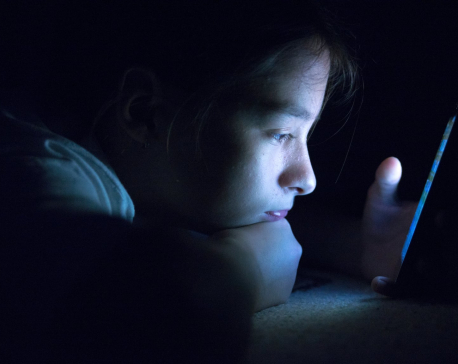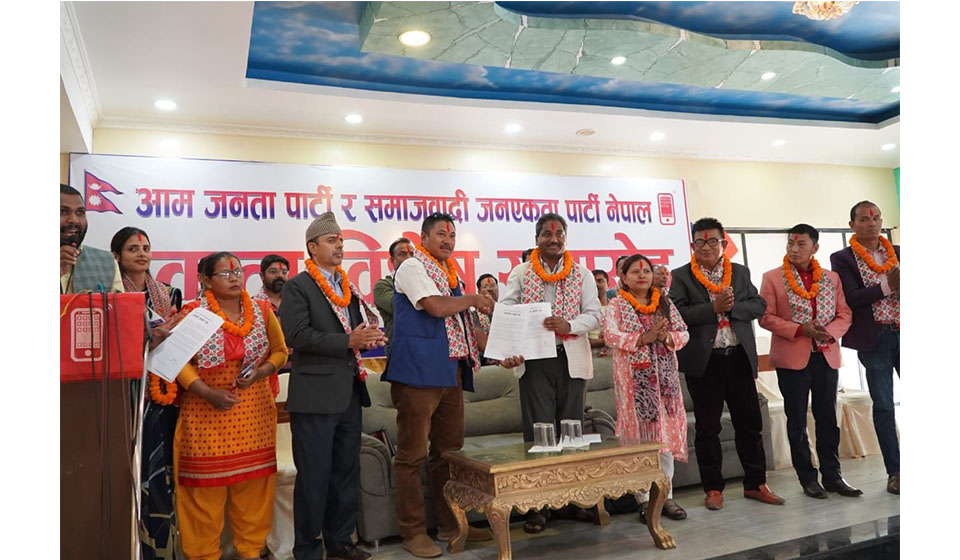
OR
Opinion
Social Media: A Seedbed for Juvenile Delinquency
Published On: September 25, 2023 09:15 AM NPT By: Diwakar Dhakal

Ultimately, social media is a double-edged sword; it can be full of flowers or it can be a pit of pity, which depends upon individual users.
Youngsters’ involvement with social media has ingrained itself into their daily routine in today's digital age. In its true form, teenage criminal conduct on various social media platforms is greatly facilitated by Internet-based applications. The juveniles are children who, unlike adults, have not reached the legal age, are not held accountable for their actions until they are transferred to a correctional center. Juvenile delinquency is defined as any antisocial or illegal behavior perpetrated by a person under the age of 18. As a result, juvenile crime on social media is rapidly expanding around the globe, and Nepal is not an exception.
Child and Social Media
Every child is born with a specific set of traits, such as being playful, bold, fragile, and incapable of making key-life choices. The rise of social networking websites like Facebook, Instagram, Twitter, TikTok, and others puts children at risk while they are online. Nowadays, social media is used for all kinds of common teenage infractions that can be itemized. Sexting (creating and disseminating one's sexual content), copyright infringement (sending digital music and movies without the owner's permission), Facebook depression (typical depressive symptoms), fear of missing out (reacting quickly), and publishing pornographic content are a multitude of these behaviors. Its over-indulgence and exposition could end up in dejection and solitude, both of which have an unfavorable effect on children's activity. Identically, Martin Gurri (The Revolt of the Public and the Crisis of Authority in the New Millennium, 2018) observed the new information universe in which digital media combined with legacy media began to overwhelm everyone with more information than they had ever had access to previously or could make sense of. As time passed, it became evident that social media as a source of information among today's children is widely salacious and sensationalized behind a veil of secrecy.
In Nepal, there is no mechanism for age verification for the installation of apps or their usage. The mushrooming of abundant accounts in the age of digital transcendence not only poses a challenge to digital platforms but also erodes everyone’s zone of privacy. Nowadays, most teenagers relish traversing it; however, the growing proportion of young people's time in the digital world may push them into some illegal online space, turning them into juvenile felons before they even realize it. For instance, in 2019, a 15-year-old boy allegedly killed his elder brother after being upbraided for playing the PUBG game on his mobile in India, in Maharashtra’s Thane district. Also, an 18-year-old resident of Kapilvastu was apprehended in 2021 by the cybercrime bureau of Nepal Police on charges of creating and running a bogus Facebook profile of the cybercrime bureau of Nepal Police. In addition, when practiced online as cyberbullying, an offense that was once fairly prevalent among teenagers—teasing other students about their names and appearances in class—has mutated into something more fatal. Therefore, many young children are embroiled in it with no thought about the repercussions of landing unsafely with the law.
Legal framework for the juvenile justice system
International Instruments
The Universal Declaration of Human Rights (UDHR) of 1948 encompasses human rights and the freedom of humans and was ratified by Nepal in 1991. It not only includes the rights of adults; it also includes the rights of children for their proper physical, mental, and spiritual health. The International Covenant on Civil and Political Rights (ICCPR) of 1966, which deals with laws relating to juvenile justice, was enacted by the world community in 1966 and ratified by Nepal on August 14, 1991. The Convention on the Rights of the Child (CRC) of 1989, a crucial international law addressing the subject of children's rights, was ratified by Nepal on September 14, 1990. Hence, Nepal was one of the first few countries to adopt this convention to safeguard and uphold the rights of children.
Domestic legislations
There are no specific laws and regulations that deal with the juvenile delinquency constituted by social media in Nepal. Nevertheless, the following laws have played a vital role in addressing juvenile justice in various ways: The Constitution of Nepal 2015, Article 39(6), epitomizes that children are not subjected to abuse of any form, whether physical, mental, sexual, or other forms of exploitation, by any means or in any manner. The Act Relating to Children, 2018 was introduced to maintain the proper interests of children by respecting, promoting, protecting, and fulfilling their rights. The act has guaranteed the children’s right to privacy, stating that any personal information, pictures, videos, etc. should not be sold or distributed that causes harm, shame, or regret to the children. The Electronic Transaction Act, 2008, was introduced to ensure the proper security of electronic transactions and to control the unauthorized use of electronic records. The Act prohibits publishing and displaying any kind of materials that are contrary to public morality and decent behavior in electronic media like computers and the internet, which are prohibited to publish and display by the law.
Moreover, the 2017 National Penal Code clearly outlaws child sexual abuse, stating that it will be considered child sexual abuse if individuals produce, publish, or print any kind of image, drawing, film, book, or other item that is salacious or promotes libidinous interest. In addition, there are numerous laws and regulations pertaining to juvenile shortcomings. The State Cases Act 2049 (1992), the Social Welfare Act 2049 (1992), the Evidence Act 2031 (1974), the Human Trafficking Control Act 2064 (2007), the Police Act 2012 (1955), the Prison Act 2019 (1963), and a number of rules," including Court Rules," have prescribed provisions that jointly create the Nepalese juvenile justice system.
What can be done?
Children are more curious in today's evolving network-centric applications while they are unaware of their unlawful behavior, whether wittingly or unwittingly, since it is unforeseeable to them. In fact, the family plays a pivotal role in the personality development of children in Nepal, as anywhere else, in regards to digital danger. Moreover, due to their obsession with social media apps, they are more exposed before they gain a sense of right and wrong in society, which consequently threatens their social lives. Children must be raised with parental responsibility, so parents must maintain a watchful eye on what their children are doing digitally.
Most notably, there are several nations with legislations that limit minors’ usage of social media in general. For instance, the Children's Online Privacy Protection Act (COPPA) in the United States prohibits social media companies from accumulating personal information from children under the age of 13 without parental consent. Additionally, the processing of personal data of minors under the age of 16 is strictly forbidden by the General Data Protection Regulation (GDPR) of the European Union. This is attributed to the notion that children are more vulnerable to the downsides associated with data processing, such as being manipulated or exploited. The Data Protection Act of 2018 in the UK and the Privacy Act of 1988 in Australia both safeguard the interests of minors. As stated in Nepal's Privacy Act 2075 (2018), a minor's personal information can only be accessed, published, or disclosed with their guardian's or other responsible adult's authorization. Therefore, it is a collective journey where everyone should make worthwhile efforts to combat it.
Scientifically, teenagers mostly possess the amygdala brain, an emotional process driven by self-gratification. They are creating videos, morphing visuals, and championing a sarcastic culture with a carefree preoccupation with transient levity, which violates moral and societal norms. As such, it is essential to have a complete understanding of moral, ethical, and legal gravity, as well as potential outcomes. Furthermore, by restricting age limits and regulating children's access to social media, legislation can be helpful in imposing embargoes and prohibitions on its use. Therefore, an integral component of positive development for children includes education and personal growth.
Conclusion
Ultimately, social media is a double-edged sword; it can be full of flowers or it can be a pit of pity, which depends upon individual users. Although it has become a major part of many young people's lives, it also has the potential to act as a seedbed for juvenile offenders. The undue use of it creates a pathway for people to be influenced by the spine-chilling stories of the virtual world to act in the real world. In addition, a handful of the aforementioned instances manifest that social networking sites act as an array to commit illegal acts and meddle with children's cognitive landscapes, which is worrying for the future of youth as well as the nation. Therefore, it is urgent to protect youthfulness from falling prey to this minefield.
You May Like This

Children's lack of sleep is 'hidden health crisis', experts say
NHS statistics for England show sleep disorder admissions for under-16s was almost 10,000 last year ... Read More...

16-24 year old most likely to be lonely, study finds
The pressure to present the "perfect" life on social media could be a factor. ... Read More...

Save children from social media
I am sure you will agree with me when I say social media plays a role in our lives. I... Read More...


Just In
- Sunkoshi-Marin Diversion Project’s tunnel construction nears completion, breakthrough scheduled for May 8
- Govt tightens security arrangement for Third Investment Summit 2024
- Pesticide residue found in vegetables in Nepalgunj
- Aam Janata Party and Samajwadi Jana Ekata Party merge
- 1,600 participants confirmed for Nepal Investment Summit
- Ilam-2 by-elections held peacefully, vote count likely to start tonight
- NEA schedules five-day power cut across Kathmandu Valley for underground cable installation
- Hundreds of passengers including foreign tourists in distress as poor visibility halts flights to and from PRIA















-1200x560-wm_20240427144118.jpg)
Leave A Comment